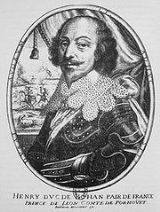
Huguenot rebellions
Encyclopedia
The Huguenot rebellions, sometimes called the Rohan Wars after the Huguenot
leader Henri de Rohan
, refers to events of the 1620s in which French
Protestants (Huguenots), mainly located in southwestern France
, revolted against royal authority. The uprising occurred a decade following the death of Henry IV
, who, himself originally a Huguenot before converting to Catholicism
, had protected Protestants through the Edict of Nantes
. His successor Louis XIII, under the regency of his Italian Catholic mother Marie de' Medici
, became more intolerant of Protestantism. The Huguenots tried to respond by defending themselves, establishing independent political and military structures, establishing diplomatic contacts with foreign powers, and openly revolting against central power. The Huguenot rebellions came after two decades of internal peace under Henry IV, following the intermittent French Wars of Religion
of 1562–1598.

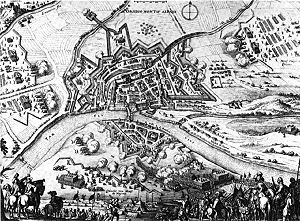 The first Huguenot rebellion was triggered by the re-establishment of Catholic rights in Huguenot Béarn
The first Huguenot rebellion was triggered by the re-establishment of Catholic rights in Huguenot Béarn
by Louis XIII in 1617, and the military annexation Béarn to France in 1620, with the occupation of Pau in October 1620. The government was replaced by a French-style parliament in which only Catholics could sit.
Feeling their survival was at stake, the Huguenots gathered in La Rochelle on 25 December 1620. At this Huguenot General Assembly in La Rochelle the decision was taken to forcefully resist the Royal threat, and to establish a "state within the state", with an independent military commandment and independent taxes, under the direction of Duc de Rohan
, an ardent proponent of open conflict with the King. In that period, the Huguenots were very defiant of the Crown, displaying intentions to become independent on the model of the Dutch Republic
: "If the citizens, abandoned to their guidance, were threateneed in their rights and creeds, they would imitate the Dutch
in their resistance to Spain
, and defy all the power of the monarchy to reduce them." (Mercure de France
)
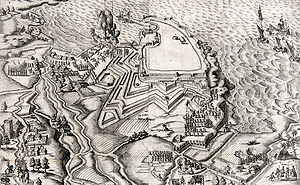
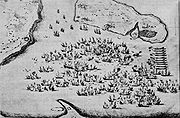 In 1621, Louis XIII moved to eradicate what he considered an open rebellion against his power. He led an army to the south, first succeeding in capturing the Huguenot city of Saumur
In 1621, Louis XIII moved to eradicate what he considered an open rebellion against his power. He led an army to the south, first succeeding in capturing the Huguenot city of Saumur
, and then succeeding in the Siege of Saint-Jean-d'Angély
against Rohan's brother Benjamin de Rohan, duc de Soubise
on 24 June 1621. A small number of troops attempted to surround La Rochelle
under the Count of Soissons in the Blockade of La Rochelle
, but Louis XIII then moved south to Montauban
, where he exhausted his troops in the Siege of Montauban
.
After a lull, combat resumed with numerous atrocities in 1622, with the terrible Siege of Nègrepelisse
in which all the population was massacred and the city was burnt to the ground.
In La Rochelle, the fleet of the city under Jean Guiton
started to harass royal vessels and bases. The Royal fleet finally met head-to-head with the fleet of La Rochelle in the Naval battle of Saint-Martin-de-Ré
on 27 October 1622 in an inconclusive encounter.
Meanwhile, the Treaty of Montpellier
was negotiated, putting an end to hostilities. The Huguenot fortresses of Montauban
and La Rochelle could be kept, but the fortress of Montpellier
had to be dismantled.
The year 1624 saw the arrival of Cardinal Richelieu to power as chief minister, which would mean much harder times ahead for the Protestants.
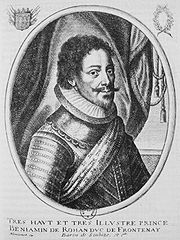
 Louis XIII did not, however, uphold the terms of the Treaty of Montpellier, sparking renewed Huguenot resentment. Toiras reinforced the fortification of Fort Louis
Louis XIII did not, however, uphold the terms of the Treaty of Montpellier, sparking renewed Huguenot resentment. Toiras reinforced the fortification of Fort Louis
, instead of dismantling it, right under the walls of the Huguenot stronghold of La Rochelle
, and as a strong fleet was being prepared in Blavet for the eventuality of a siege of the city. The threat of a future siege on the city of La Rochelle was obvious, both to Soubise and the people of La Rochelle.
In February 1625, Soubise led a second Huguenot revolt against Louis XIII, and, after publishing a manifesto, invaded and occupied the island of Ré, near La Rochelle. From there he sailed up to Brittany where he led a successful attack on the royal fleet in the Battle of Blavet
, although he could not take the fort after a three weeks siege. Soubise then returned to Ré with 15 ships and soon occupied the Ile d'Oléron as well, thus giving him command of the Atlantic coast from Nantes
to Bordeaux
. Through these deeds, he was recognized as the head of the Huguenots, and named himself "Admiral of the Protestant Church". The French Navy on the contrary was now completely depleted, leaving the central government very vulnerable.
The Huguenot city of La Rochelle voted to join Soubise on 8 August 1625. These events would end with the defeat of the fleets of La Rochelle and Soubise, and the full Capture of Ré island
by September 1625.
After long negotiations, a peace agreement, the Treaty of Paris
, was finally signed between the city of La Rochelle and king Louis XIII on 5 February 1626, preserving religious freedom but imposing some guaranties against possible future upheavals: in particular, La Rochelle was prohibited from keeping a naval fleet.

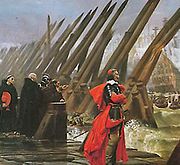 The third and last Huguenot rebellion started with an English military intervention aimed at encouraging an upheaval against the French king. The rebels had received the backing of the English king Charles I
The third and last Huguenot rebellion started with an English military intervention aimed at encouraging an upheaval against the French king. The rebels had received the backing of the English king Charles I
, who sent his favourite
George Villiers, 1st Duke of Buckingham
with a fleet of 80 ships. In June 1627 Buckingham organised a landing on the nearby island of Île de Ré with 6,000 men in order to help the Huguenots, thus starting an Anglo-French War (1627-1629)
, with the objective of controlling the approaches to La Rochelle, and of encouraging the rebellion in the city. Buckingham ultimately ran out of money and support, and his army was weakened by diseases. The English intervention ended with the unsuccessful Siege of Saint-Martin-de-Ré (1627)
. After a last attack on Saint-Martin they were repulsed with heavy casualties, and left in their ships.
The English intervention was followed by the Siege of La Rochelle
. Cardinal Richelieu acted as the commander of the besieging troops (during those times when the King was absent). Residents of La Rochelle resisted for 14 months, under the leadership of the mayor Jean Guitton and with gradually diminishing help from England. During the siege, the population of La Rochelle decreased from 27,000 to 5,000 due to casualties, famine and disease. Surrender was unconditional.
Rohan continued to resist in Southern France, where the forces of Louis XIII continued to intervene in 1629. In the Siege of Privas
, the inhabitants were massacred or expelled, and the city was burnt to the ground. Louis XIII finally captures Alès, in the Siege of Alès
in June 1629, and Rohan submitted.
By the terms of the Peace of Alais
, the Huguenots lost their territorial, political and military rights, but retained the religious freedom granted by the Edict of Nantes
. However, they were left at the mercy of the monarchy, unable to resist when the next king, Louis XIV, embarked on active persecution in the 1670s, and finally revoked the Edict of Nantes altogether in 1685.
central government in France, which would have a decisive influence on French history over the ensuing centuries.
Huguenot
The Huguenots were members of the Protestant Reformed Church of France during the 16th and 17th centuries. Since the 17th century, people who formerly would have been called Huguenots have instead simply been called French Protestants, a title suggested by their German co-religionists, the...
leader Henri de Rohan
Henri, duc de Rohan
Henri de Rohan, Viscount then Duke of Rohan , later duke of Rohan, French soldier, writer and leader of the Huguenots, was born at the Château de Blain , in Brittany....
, refers to events of the 1620s in which French
French people
The French are a nation that share a common French culture and speak the French language as a mother tongue. Historically, the French population are descended from peoples of Celtic, Latin and Germanic origin, and are today a mixture of several ethnic groups...
Protestants (Huguenots), mainly located in southwestern France
France
The French Republic , The French Republic , The French Republic , (commonly known as France , is a unitary semi-presidential republic in Western Europe with several overseas territories and islands located on other continents and in the Indian, Pacific, and Atlantic oceans. Metropolitan France...
, revolted against royal authority. The uprising occurred a decade following the death of Henry IV
Henry IV of France
Henry IV , Henri-Quatre, was King of France from 1589 to 1610 and King of Navarre from 1572 to 1610. He was the first monarch of the Bourbon branch of the Capetian dynasty in France....
, who, himself originally a Huguenot before converting to Catholicism
Catholicism
Catholicism is a broad term for the body of the Catholic faith, its theologies and doctrines, its liturgical, ethical, spiritual, and behavioral characteristics, as well as a religious people as a whole....
, had protected Protestants through the Edict of Nantes
Edict of Nantes
The Edict of Nantes, issued on 13 April 1598, by Henry IV of France, granted the Calvinist Protestants of France substantial rights in a nation still considered essentially Catholic. In the Edict, Henry aimed primarily to promote civil unity...
. His successor Louis XIII, under the regency of his Italian Catholic mother Marie de' Medici
Marie de' Medici
Marie de Médicis , Italian Maria de' Medici, was queen consort of France, as the second wife of King Henry IV of France, of the House of Bourbon. She herself was a member of the wealthy and powerful House of Medici...
, became more intolerant of Protestantism. The Huguenots tried to respond by defending themselves, establishing independent political and military structures, establishing diplomatic contacts with foreign powers, and openly revolting against central power. The Huguenot rebellions came after two decades of internal peace under Henry IV, following the intermittent French Wars of Religion
French Wars of Religion
The French Wars of Religion is the name given to a period of civil infighting and military operations, primarily fought between French Catholics and Protestants . The conflict involved the factional disputes between the aristocratic houses of France, such as the House of Bourbon and House of Guise...
of 1562–1598.
First Huguenot rebellion (1620-1622)


Béarn
Béarn is one of the traditional provinces of France, located in the Pyrenees mountains and in the plain at their feet, in southwest France. Along with the three Basque provinces of Soule, Lower Navarre, and Labourd, the principality of Bidache, as well as small parts of Gascony, it forms in the...
by Louis XIII in 1617, and the military annexation Béarn to France in 1620, with the occupation of Pau in October 1620. The government was replaced by a French-style parliament in which only Catholics could sit.
Feeling their survival was at stake, the Huguenots gathered in La Rochelle on 25 December 1620. At this Huguenot General Assembly in La Rochelle the decision was taken to forcefully resist the Royal threat, and to establish a "state within the state", with an independent military commandment and independent taxes, under the direction of Duc de Rohan
Henri, duc de Rohan
Henri de Rohan, Viscount then Duke of Rohan , later duke of Rohan, French soldier, writer and leader of the Huguenots, was born at the Château de Blain , in Brittany....
, an ardent proponent of open conflict with the King. In that period, the Huguenots were very defiant of the Crown, displaying intentions to become independent on the model of the Dutch Republic
Dutch Republic
The Dutch Republic — officially known as the Republic of the Seven United Netherlands , the Republic of the United Netherlands, or the Republic of the Seven United Provinces — was a republic in Europe existing from 1581 to 1795, preceding the Batavian Republic and ultimately...
: "If the citizens, abandoned to their guidance, were threateneed in their rights and creeds, they would imitate the Dutch
Netherlands
The Netherlands is a constituent country of the Kingdom of the Netherlands, located mainly in North-West Europe and with several islands in the Caribbean. Mainland Netherlands borders the North Sea to the north and west, Belgium to the south, and Germany to the east, and shares maritime borders...
in their resistance to Spain
Spain
Spain , officially the Kingdom of Spain languages]] under the European Charter for Regional or Minority Languages. In each of these, Spain's official name is as follows:;;;;;;), is a country and member state of the European Union located in southwestern Europe on the Iberian Peninsula...
, and defy all the power of the monarchy to reduce them." (Mercure de France
Mercure de France
The Mercure de France was originally a French gazette and literary magazine first published in the 17th century, but after several incarnations has evolved as a publisher, and is now part of the Éditions Gallimard publishing group....
)


Saumur
Saumur is a commune in the Maine-et-Loire department in western France.The historic town is located between the Loire and Thouet rivers, and is surrounded by the vineyards of Saumur itself, Chinon, Bourgueil, Coteaux du Layon, etc...
, and then succeeding in the Siege of Saint-Jean-d'Angély
Siege of Saint-Jean-d'Angély
The Siege of Saint-Jean-d'Angély was a siege, , accomplished by the young French king Louis XIII in 1621, against the Protestant stronghold of Saint-Jean-d'Angély led by Rohan's brother Benjamin de Rohan, duc de Soubise...
against Rohan's brother Benjamin de Rohan, duc de Soubise
Benjamin de Rohan, duc de Soubise
Benjamin de Rohan, duc de Soubise , was a French Huguenot leader.The younger brother of Henri de Rohan, he inherited his title through his mother Catherine of Parthenay. He served his apprenticeship as a soldier under Maurice of Nassau in the Low Countries...
on 24 June 1621. A small number of troops attempted to surround La Rochelle
La Rochelle
La Rochelle is a city in western France and a seaport on the Bay of Biscay, a part of the Atlantic Ocean. It is the capital of the Charente-Maritime department.The city is connected to the Île de Ré by a bridge completed on 19 May 1988...
under the Count of Soissons in the Blockade of La Rochelle
Blockade of La Rochelle
The Blockade of La Rochelle took place in 1621-1622 during the repression of the Huguenot rebellion by the French king Louis XIII....
, but Louis XIII then moved south to Montauban
Montauban
Montauban is a commune in the Tarn-et-Garonne department in the Midi-Pyrénées region in southern France. It is the capital of the department and lies north of Toulouse....
, where he exhausted his troops in the Siege of Montauban
Siege of Montauban
The Siege of Montauban was a siege accomplished by the young French king Louis XIII in 1621, against the Protestant stronghold of Montauban...
.
After a lull, combat resumed with numerous atrocities in 1622, with the terrible Siege of Nègrepelisse
Siege of Nègrepelisse
The Siege of Nègrepelisse was a siege accomplished by the young French king Louis XIII in 1622, against the Protestant stronghold of Nègrepelisse in France...
in which all the population was massacred and the city was burnt to the ground.
In La Rochelle, the fleet of the city under Jean Guiton
Jean Guiton
Jean Guiton was born in La Rochelle where he followed the occupation of ship-owner.Having been nominated Admiral of the fleet of La Rochelle, Jean Guiton fought the Naval battle of Saint-Martin-de-Ré against Royal forces on 27 October 1622....
started to harass royal vessels and bases. The Royal fleet finally met head-to-head with the fleet of La Rochelle in the Naval battle of Saint-Martin-de-Ré
Naval battle of Saint-Martin-de-Ré
The Naval battle of Saint-Martin-de-Ré took place on 27 October 1622, between the Huguenot fleet of La Rochelle under Jean Guiton, and a Royal fleet under Charles de Guise....
on 27 October 1622 in an inconclusive encounter.
Meanwhile, the Treaty of Montpellier
Treaty of Montpellier
The Treaty of Montpellier was signed in Montpellier on October 18, 1622 between King Louis XIII of France and Duke Henry II of Rohan. The treaty followed the Siege of Montpellier and ended hostilities between French royalists and the Huguenots...
was negotiated, putting an end to hostilities. The Huguenot fortresses of Montauban
Montauban
Montauban is a commune in the Tarn-et-Garonne department in the Midi-Pyrénées region in southern France. It is the capital of the department and lies north of Toulouse....
and La Rochelle could be kept, but the fortress of Montpellier
Montpellier
-Neighbourhoods:Since 2001, Montpellier has been divided into seven official neighbourhoods, themselves divided into sub-neighbourhoods. Each of them possesses a neighbourhood council....
had to be dismantled.
The year 1624 saw the arrival of Cardinal Richelieu to power as chief minister, which would mean much harder times ahead for the Protestants.
Second Huguenot rebellion (1625)


Fort Louis (La Rochelle)
Fort Louis was a Royal fort built just outside the walls of the Huguenot city in La Rochelle.The fort was a source of great tension between the Huguenots of La Rochelle and Louis XIII, and was perceived as a real threat to their survival...
, instead of dismantling it, right under the walls of the Huguenot stronghold of La Rochelle
La Rochelle
La Rochelle is a city in western France and a seaport on the Bay of Biscay, a part of the Atlantic Ocean. It is the capital of the Charente-Maritime department.The city is connected to the Île de Ré by a bridge completed on 19 May 1988...
, and as a strong fleet was being prepared in Blavet for the eventuality of a siege of the city. The threat of a future siege on the city of La Rochelle was obvious, both to Soubise and the people of La Rochelle.
In February 1625, Soubise led a second Huguenot revolt against Louis XIII, and, after publishing a manifesto, invaded and occupied the island of Ré, near La Rochelle. From there he sailed up to Brittany where he led a successful attack on the royal fleet in the Battle of Blavet
Battle of Blavet
The Battle of Blavet was an encounter between the Huguenot forces of Soubise and a French fleet under the Duke of Nevers in Blavet harbour , Brittany in January 1625, triggering the Second Huguenot rebellion against the Crown of France.-Background:An important Huguenot rebellion against the...
, although he could not take the fort after a three weeks siege. Soubise then returned to Ré with 15 ships and soon occupied the Ile d'Oléron as well, thus giving him command of the Atlantic coast from Nantes
Nantes
Nantes is a city in western France, located on the Loire River, from the Atlantic coast. The city is the 6th largest in France, while its metropolitan area ranks 8th with over 800,000 inhabitants....
to Bordeaux
Bordeaux
Bordeaux is a port city on the Garonne River in the Gironde department in southwestern France.The Bordeaux-Arcachon-Libourne metropolitan area, has a population of 1,010,000 and constitutes the sixth-largest urban area in France. It is the capital of the Aquitaine region, as well as the prefecture...
. Through these deeds, he was recognized as the head of the Huguenots, and named himself "Admiral of the Protestant Church". The French Navy on the contrary was now completely depleted, leaving the central government very vulnerable.
The Huguenot city of La Rochelle voted to join Soubise on 8 August 1625. These events would end with the defeat of the fleets of La Rochelle and Soubise, and the full Capture of Ré island
Capture of Ré island
The Recovery of Ré Island was accomplished by the army of Louis XIII in September 1625, against the troops of the Protestant admiral Soubise and the Huguenot forces of La Rochelle, who had been occupying the Island of Ré since February 1625 as part of the Huguenot rebellions.-Background:The...
by September 1625.
After long negotiations, a peace agreement, the Treaty of Paris
Treaty of Paris (1626)
The Treaty of Paris was a peace agreement between king Louis XIII and the Huguenots following the outbreak of the Second Huguenot rebellion and the Capture of Ré island....
, was finally signed between the city of La Rochelle and king Louis XIII on 5 February 1626, preserving religious freedom but imposing some guaranties against possible future upheavals: in particular, La Rochelle was prohibited from keeping a naval fleet.
Third Huguenot rebellion (1627-1628)


Charles I of England
Charles I was King of England, King of Scotland, and King of Ireland from 27 March 1625 until his execution in 1649. Charles engaged in a struggle for power with the Parliament of England, attempting to obtain royal revenue whilst Parliament sought to curb his Royal prerogative which Charles...
, who sent his favourite
Favourite
A favourite , or favorite , was the intimate companion of a ruler or other important person. In medieval and Early Modern Europe, among other times and places, the term is used of individuals delegated significant political power by a ruler...
George Villiers, 1st Duke of Buckingham
George Villiers, 1st Duke of Buckingham
George Villiers, 1st Duke of Buckingham KG was the favourite, claimed by some to be the lover, of King James I of England. Despite a very patchy political and military record, he remained at the height of royal favour for the first two years of the reign of Charles I, until he was assassinated...
with a fleet of 80 ships. In June 1627 Buckingham organised a landing on the nearby island of Île de Ré with 6,000 men in order to help the Huguenots, thus starting an Anglo-French War (1627-1629)
Anglo-French War (1627-1629)
The Anglo-French war of 1627-1629 was part of the Thirty Years' War. It mainly involved actions at sea. The centre of the conflict surrounded the Siege of La Rochelle, in which the English crown supported the French Huguenots in their fight against the French royal forces of Louis XIII of France in...
, with the objective of controlling the approaches to La Rochelle, and of encouraging the rebellion in the city. Buckingham ultimately ran out of money and support, and his army was weakened by diseases. The English intervention ended with the unsuccessful Siege of Saint-Martin-de-Ré (1627)
Siege of Saint-Martin-de-Ré (1627)
The Siege of Saint-Martin-de-Ré, also Siege of St. Martin's , occurred in the French isle of Ile de Ré around the fortress of the city of Saint-Martin-de-Ré, when Duke of Buckingham tried to occupy the island in 1627...
. After a last attack on Saint-Martin they were repulsed with heavy casualties, and left in their ships.
The English intervention was followed by the Siege of La Rochelle
Siege of La Rochelle
The Siege of La Rochelle was a result of a war between the French royal forces of Louis XIII of France and the Huguenots of La Rochelle in 1627-1628...
. Cardinal Richelieu acted as the commander of the besieging troops (during those times when the King was absent). Residents of La Rochelle resisted for 14 months, under the leadership of the mayor Jean Guitton and with gradually diminishing help from England. During the siege, the population of La Rochelle decreased from 27,000 to 5,000 due to casualties, famine and disease. Surrender was unconditional.
Rohan continued to resist in Southern France, where the forces of Louis XIII continued to intervene in 1629. In the Siege of Privas
Siege of Privas
The Siege of Privas was undertaken by Louis XIII of France from 14 May 1629, and the city of Privas was captured on 28 May 1629. It was one of the last events of the Huguenot rebellions .-Context:...
, the inhabitants were massacred or expelled, and the city was burnt to the ground. Louis XIII finally captures Alès, in the Siege of Alès
Siege of Alès
The Siege of Alès was undertaken by Louis XIII of France, and the city captured in 17 June 1629.-The siege:The Siege of Alès followed the disastrous capitulation of the main Protestant stronghold of La Rochelle, in the Siege of La Rochelle. Huguenot resistance persisted in the south of France...
in June 1629, and Rohan submitted.
By the terms of the Peace of Alais
Peace of Alais
The Peace of Alais, also known as the Edict of Alès or the Edict of Grace, was a treaty negotiated by Cardinal Richelieu with Huguenot leaders and signed by King Louis XIII of France on 27 September 1629...
, the Huguenots lost their territorial, political and military rights, but retained the religious freedom granted by the Edict of Nantes
Edict of Nantes
The Edict of Nantes, issued on 13 April 1598, by Henry IV of France, granted the Calvinist Protestants of France substantial rights in a nation still considered essentially Catholic. In the Edict, Henry aimed primarily to promote civil unity...
. However, they were left at the mercy of the monarchy, unable to resist when the next king, Louis XIV, embarked on active persecution in the 1670s, and finally revoked the Edict of Nantes altogether in 1685.
Aftermath
The Huguenot rebellions were implacably suppressed by the French Crown. As a consequence, the Huguenots lost their political power, and ultimately their religious freedom in the Kingdom of France with the Revocation of the Edict of Nantes in 1685. These events were one of the factors effecting an unusually strong AbsolutistAbsolute monarchy
Absolute monarchy is a monarchical form of government in which the monarch exercises ultimate governing authority as head of state and head of government, his or her power not being limited by a constitution or by the law. An absolute monarch thus wields unrestricted political power over the...
central government in France, which would have a decisive influence on French history over the ensuing centuries.

